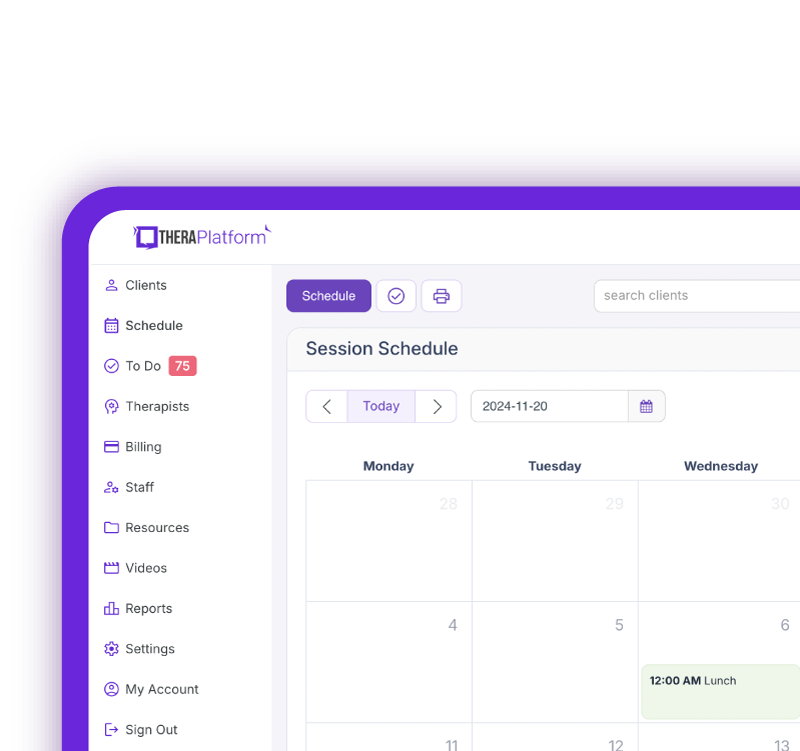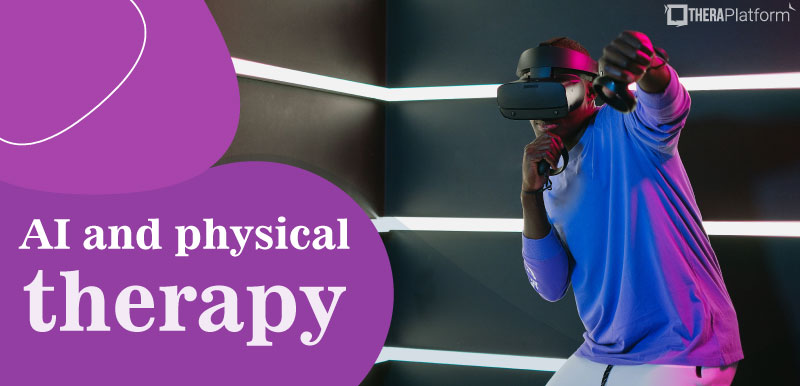How PTs use AI to personalize treatment plans

Artificial intelligence (AI) development and application are benefiting the medical and healthcare industries. From frontline patient care to back office billing practices, AI is gaining a foothold everywhere. Despite valid concerns around the rapid pace and ethical considerations of AI implementation, there are undoubtedly many positives to these technological advances. AI technology is here to stay, and the time has come to jump on board or risk getting left behind.
Summary
- AI is enhancing physical therapy by supporting personalized treatment plans, real-time monitoring, movement analysis, and virtual coaching—empowering therapists with data-driven insights for better outcomes.
- Wearable technology and movement analysis tools help therapists collect detailed patient data, track progress, and optimize care, especially for athletic and neurologically impaired populations.
- AI integration in EHRs streamlines documentation, assists in clinical decision-making, and helps identify diagnosis codes, reducing administrative burden and improving accuracy.
- Ethical and practical considerations remain critical, including data privacy, algorithm reliability, cost, and equitable access—underscoring that AI is a tool to support, not replace, clinical judgment.
Streamline your practice with One EHR
- Scheduling
- Flexible notes
- Template library
- Billing & payments
- Insurance claims
- Client portal
- Telehealth
- E-fax

At this point, almost everyone has heard of AI, but few understand how it works. At its most basic level, artificial intelligence relies on computer programs using techniques like deep learning, machine learning, or natural language processing to gather, interpret, and store large amounts of data, which it subsequently uses to perform predictions and other functions based on what it has "learned".
Gradually, over the last 3-5 years, physical therapists have been encountering AI tools created to enhance their workflow more often.
Many of the standard AI applications available to physical therapists fall into the general categories outlined below:
- Personalized treatment plans and AI-driven assessments
- Real-time monitoring and adaptation tools
- Movement analysis
- Virtual coaching and telerehabilitation
- Predictive analytics
- Data-driven insights for preventive care
- Documentation tools
In this article, we will outline some AI applications available for PTs to enhance and individualize patient care. In addition to introducing therapists to a variety of AI applications, this article will help therapists and clinics decide whether to allocate funds and resources to invest in AI tools.
The role of AI in client care
You can find an AI tool to use at almost any point along the patient-care timeline. Physical therapists are utilizing AI in various aspects of their practice, including documentation, examination, assessment, and plan of care development.
Researcher Edelle Field-Fote, PT, PhD, FAPTA, spoke to the Foundation for Physical Therapy Research about the transformative potential for AI in the field of physical therapy. She pointed out that, while a large body of research on physical treatment exists, we still have a lot to learn about the effectiveness of certain interventions and for whom they are most effective. Using AI to analyze large datasets, she posits, combined with the existing research data, can increase the usefulness and accuracy of evidence-based practice guidelines.
Practice Management + EHR + Telehealth
Manage more in less time in your practice with TheraPlatform

Data collection using AI
AI-driven data collection programs exist in many forms. These tools utilize AI to collect and analyze user data.
Wearables, for example, have gained popularity over the last decade and can collect and interpret more data than ever.
- Wearables are wireless devices worn on the human body, often in the form of clothes, accessories, or gadgets, that can communicate a variety of data about the user.
- Smart glasses and smartwatches are two of the most popular wearable devices on the market, but the wearable industry has expanded rapidly to include a wide range of devices.
Therapists can use these devices for health monitoring, fitness tracking, and performance optimization. PTs can leverage this data to understand a patient's health status and inform decisions about their care.
Below are some examples of wearable technology that could help individualize a patient's care:
- Oura Ring
- Whoop Strap
- Continuous Glucose Monitors
- SeamFit: A project out of Cornell University using clothing to monitor posture and exercise
- HexoSkin Smart Shirts
- Tyme Wear breathing and heart rate sensors
Movement analysis software also utilizes AI technology to measure, analyze, and interpret various movements. In athletes, for example, this data can reveal risk factors for injury, provide visual feedback to improve technique, or inform a PT what interventions should be undertaken next.
Tools like ViMove+ or Kinetisense leverage 3D motion analysis to provide clinicians with a wealth of helpful information.
Athletes aren't the only population that can benefit from AI-driven movement technology, although they are a notable example. The FeetMe Insoles and the GaitRite system, for instance, were designed to measure and analyze gait impairments, helping to treat patients with gait disorders such as Parkinson's or Cerebral Palsy.
Free Resources for Therapists
Click below and help yourself to peer-created resources:

AI integration into EHR systems
Many electronic medical and health records are using AI-driven tools to optimize their platforms. Simple tools, such as identifying patient demographic information from a scanned image of a patient ID, can reduce data entry errors. Analysis of patient health data can inform clinical decision-making.
Some platforms utilize AI to suggest diagnosis codes based on your documentation, record subjective interviews, and outline pertinent points in your documentation, as well as draft letters of medical necessity and beyond. You can even utilize AI to create therapy notes, to monitor your compliance documentation and minimize your risk of an insurance audit.
Watch this video to learn how to simplify note taking
→ Start My Free Trial
→ Start My Free Trial
When it comes to clinical decision-making, AI can likely compile and analyze patient data much more effectively than a therapist can by hand, simply due to the time it takes to gather data across multiple notes and then interpret that data about critical normative values, evidence-based guidelines, and treatment algorithms.
In this way, AI tools can help you gain a broader perspective on your patient's care, suggest changes or updates to your treatment plan, minimize oversights, and streamline care decisions.
A 2024 narrative review by Ye et al. aimed to identify and understand the role of AI in the application of electronic health records (EHRs) and patient-generated health data (PGHD) in clinical decision-making. Their review found that while more work needs to be done, AI-driven EHR-integrated PGHD looks very promising.
They concluded that the use of AI to analyze and PGHD may have several benefits:
- Improve the clinician's ability to diagnose patients' health issues
- Classify risks at the patient level by drawing on the power of integrated data provide much-needed support to clinics and hospitals
Considerations for using AI in physical therapy
Whether you are new to the world of AI or someone who loves to try out the latest technology, we hope you are excited by all the ways AI can be applied to your physical therapy practice.
With ingenuity and technological progress, however, comes responsibility, and there are several practical and ethical considerations to be aware of when implementing AI programs into your practice.
- Security and privacy: First, AI, by nature, relies on data. Patient data is subject to HIPAA and other privacy laws, and not all AI-powered technologies, such as wearable devices, are capable of collecting, storing, and transmitting data in a manner that meets these requirements. This is an important consideration when purchasing new software or technology, and an area that will continue to be of interest as more applications of AI emerge.
- Reliability and precision: Suggestions and information provided by AI systems rely heavily on the quality of data it is learning from. While high-quality research studies have narrow inclusion and exclusion criteria to enhance the generalizability of their results, there is less control over the data that a particular AI learning tool uses, meaning there will always be some room for error.
- Cost: Even the cost of AI can pose some problems. There is already a discrepancy in healthcare resources between underserved and rural communities and larger, more economically secure communities. Ethically, it is crucial to consider how the risks and benefits of AI are distributed across communities as these tools become increasingly accessible.
Ultimately, while it may be tempting to place all your faith in this powerful technology, AI is not a substitute for human expertise and therapist-derived clinical reasoning even if an AI-powered program can make perfect sense of the objective data provided by a patient, only a human therapist can take into account all of the nuances of patient interaction, important psychosocial factors and the art of physical therapy practice.
As we look to the future, we expect greater precision in AI-driven tools as more refined algorithms and larger datasets replace what we have now. In the best-case scenario, AI will alleviate the administrative burden that many therapists face and complement the skills therapists bring to the table, thereby improving patient care. One thing is sure, though: the vast majority of physical therapists will begin to work with these tools in some capacity or another, so there is no time like the present to jump in.
Streamline your practice with One EHR
- Scheduling
- Flexible notes
- Template library
- Billing & payments
- Insurance claims
- Client portal
- Telehealth
- E-fax

Resources
TheraPlatform is an all-in-one EHR, practice management, and teletherapy software built for therapists to help them save time on admin tasks. It offers a 30-day risk-free trial with no credit card required and supports different industries and sizes of practices, including physical therapists in group and solo practices.
More resources
- Therapy resources and worksheets
- Therapy private practice courses
- Ultimate teletherapy ebook
- The Ultimate Insurance Billing Guide for Therapists
- The Ultimate Guide to Starting a Private Therapy Practice
- Mental health credentialing
- Insurance billing 101
- Practice management tools
- Behavioral Health tools
Free video classes
- Free on-demand insurance billing for therapist course
- Free mini video lessons to enhance your private practice
- 9 Admin tasks to automate in your private practice
References
Elrod, R. (2024, September 2). How AI is set to transform physical therapy: Insights from Edelle Field-Fote - Foundation for Physical Therapy Research. Foundation for Physical Therapy Research. https://foundation4pt.org/how-ai-is-set-to-transform-physical-therapy-insights-from-edelle-field-fote
Huang, P., Mostovov, A., Cohen, R., Cadilhac, C., & Pionnier, R. (2025). Comparison of feetme insoles with a motion capture system coupled to force plates for assessing gait and posture. Scientific Reports, 15(1). https://doi.org/10.1038/s41598-025-96878-8
Martin, N., Leboeuf, F., & Pradon, D. (2024). The FeetMe® insoles system: repeatability, standard error of measure, and responsiveness. Sensors, 24(18), 6043. https://doi.org/10.3390/s24186043
Nahavandi, D., Alizadehsani, R., Khosravi, A., & Acharya, U. R. (2021). Application of artificial intelligence in wearable devices: Opportunities and challenges. Computer Methods and Programs in Biomedicine, 213, 106541. https://doi.org/10.1016/j.cmpb.2021.106541
Ye, J., Woods, D., Jordan, N., & Starren, J. (2024, May 31). The role of artificial intelligence for the application of integrating electronic health records and patient-generated data in clinical decision support. https://pmc.ncbi.nlm.nih.gov/articles/PMC11141850



